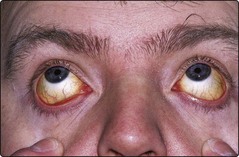14 In classification of the haemolytic anaemias there are three main considerations: The simple classification in Table 14.1 relies upon division of the main clinical disorders into inherited and acquired types. In general, it can be seen that inherited disorders are intrinsic to the red cell and acquired disorders extrinsic. The inherited disorders can be subdivided depending on the site of the defect within the cell – in the membrane, in haemoglobin, or in metabolic pathways. Acquired disorders (discussed in the next section) are broadly divided depending on whether the aetiology has an immune basis. Table 14.1 Classification of the haemolytic anaemias Recognition of the general clinical and laboratory features of haemolysis usually precedes diagnosis of a particular clinical syndrome. Where haemolysis leads to significant anaemia the resultant symptoms are as for other causes of anaemia. However, the increased red cell breakdown of the haemolytic anaemias causes an additional set of problems. Accelerated catabolism of haemoglobin releases increased amounts of bilirubin into the plasma such that patients may present with jaundice (Fig 14.1). Where the spleen is a major site of red cell destruction there may be palpable splenomegaly. Severe prolonged haemolytic anaemia in childhood can lead to expansion of the marrow cavity and associated skeletal abnormalities including frontal bossing of the skull.
Haemolytic anaemia I – General features and inherited disorders
General features of haemolysis
 The mode of acquisition of the disease: is it an inherited disorder or a disorder acquired in later life?
The mode of acquisition of the disease: is it an inherited disorder or a disorder acquired in later life?
 The location of the abnormality: is the abnormality within the red cell (intrinsic) or outside it (extrinsic)?
The location of the abnormality: is the abnormality within the red cell (intrinsic) or outside it (extrinsic)?
 The site of red cell destruction: red cells may be prematurely destroyed in the bloodstream (intravascular haemolysis) or outside it in the spleen and liver (extravascular haemolysis).
The site of red cell destruction: red cells may be prematurely destroyed in the bloodstream (intravascular haemolysis) or outside it in the spleen and liver (extravascular haemolysis).
Inherited disorders
Red cell membrane
Hereditary spherocytosis and hereditary elliptocytosis
Haemoglobin
Thalassaemia syndromes and sickling disorders
Metabolic pathways
Glucose-6-phosphate dehydrogenase and pyruvate kinase deficiency
Acquired disorders
Immune
Warm and cold autoimmune haemolytic anaemia
Isoimmune
Rhesus or ABO incompatibility (e.g. haemolytic disease of newborn, haemolytic transfusion reaction)
Non-immune and trauma
Valve prostheses, microangiopathy, infection, drugs or chemicals, hypersplenism
Diagnosis of a haemolytic anaemia
![]()
Stay updated, free articles. Join our Telegram channel

Full access? Get Clinical Tree


Haemolytic anaemia I – General features and inherited disorders

